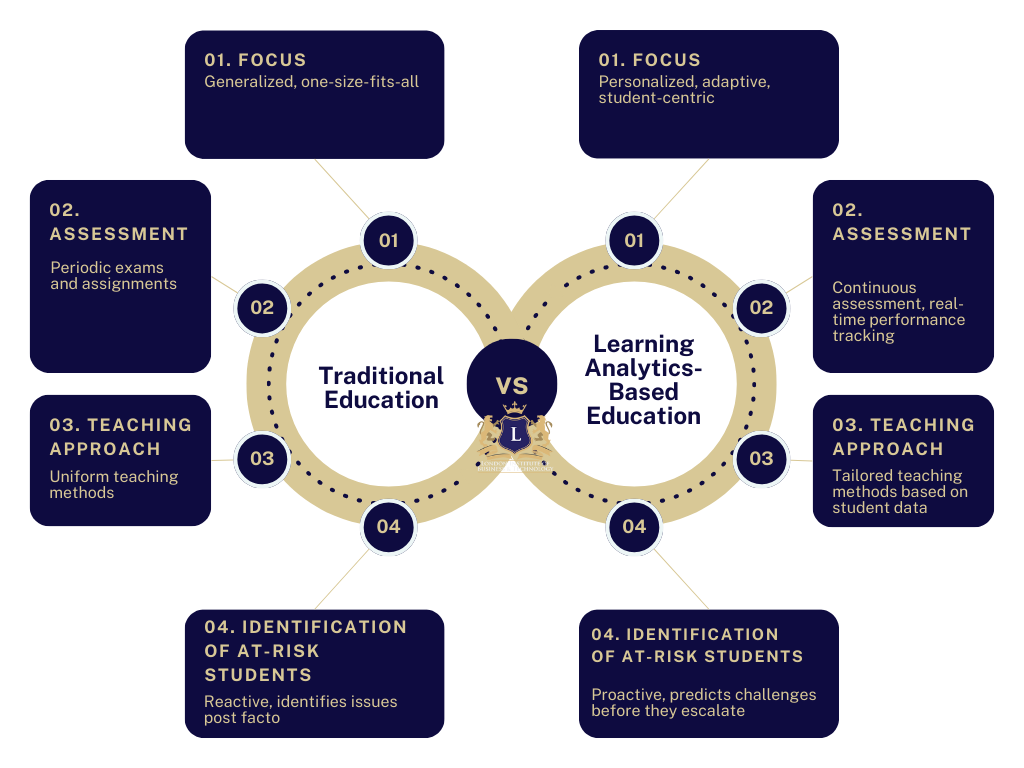The world is evolving, communication methods are shifting, and education is no exception. Clinging to traditional structures in the face of change becomes increasingly futile. With a wealth of freely accessible knowledge, the rigid industrial-style education system is gradually giving way to a more decentralized approach. How can we navigate this shift? Enter learning analytics, a transformative force reshaping how we teach and unleashing fresh possibilities for student success. This article explores five key transformative aspects of learning analytics, shedding light on how it uses data to improve the learning process. Specifically, we’ll delve into its role in predictive analytics, which helps identify at-risk students early on. Join us on this journey into the future of education.
1. The Foundation of Learning Analytics
Learning analytics is more than a buzzword; it’s a systematic approach to leveraging data to gain valuable insights into the learning process. At its core, learning analytics involves the collection, analysis, and interpretation of data generated by students and educational systems, with the goal of informing educators, administrators, and policymakers about what works and what needs improvement in the educational ecosystem. This is especially important in elearning education providers. At LIBT, we utilize learning analytics as a fundamental approach to gather, analyze, and interpret data generated by both students and systems. By doing so, we strive to implement real-time, evidence-based decision-making to enhance the quality and effectiveness of our online education delivery.

2. Utilizing Data to Inform Learning
Imagine a world where educators can tailor their teaching methods to the unique needs of each student. Learning analytics brings us closer to this reality by providing a granular understanding of how students engage with educational content. By tracking online behavior, assessing assessment performance, and monitoring participation levels, learning analytics opens a window into the learning process, enabling educators to make informed decisions about instructional design and resource allocation.
This is aligned with “personalized learning” or “individualized instruction,” and draws from various pedagogical approaches and educational philosophies. We also adapt the constructivist theory, which emphasizes active learning and the construction of knowledge based on the learner’s experiences. Additionally, this system resonates with the idea of differentiated instruction, a pedagogical strategy that tailors teaching methods to accommodate diverse learning needs within a classroom.
3. Predictive Analytics
Learning analytics has a powerful feature known as predictive analytics, especially for spotting students who might face difficulties. In traditional education, we often notice struggling students only after they’ve fallen behind, making it tough to help them catch up. Learning analytics changes this by giving educators the ability to predict potential challenges before they become too difficult to overcome. This foresight allows teachers to intervene early, providing support and ensuring that students stay on track.
This predictive aspect of learning analytics involves the analysis of various data points, including but not limited to student engagement, assessment performance, and participation levels. By leveraging sophisticated algorithms and data patterns, learning analytics can identify early signs of academic challenges or potential disengagement. For instance, it may detect patterns of declining quiz scores, decreased participation in online discussions, or irregularities in study habits. The key advantage lies in the ability to intervene at an early stage. Educators, using the insights from learning analytics, can implement targeted and timely interventions to support at-risk students. These interventions might include personalized tutoring, additional resources, or alternative teaching methods tailored to the student’s specific needs.
4. Overcoming Challenges and Ethical Considerations
While the promises of learning analytics are vast, they come with their own set of challenges. Privacy concerns, data security, and the ethical use of student data are paramount considerations. Addressing these concerns head-on, educational institutions can implement robust data governance policies, ensuring transparency, security, and ethical use of the information gleaned from learning analytics.
5. The Future of Education
As we stand at the intersection of technology and education, in a society that is shifting more and more toward a creator economy (link to the creator society article), learning analytics emerges as a guiding light, illuminating the path toward a more adaptive, student-centric future. Through a nuanced understanding of student data and the proactive identification of at-risk learners, we have the tools to redefine how education is delivered and ensure that no student is left behind.
In conclusion, learning analytics is not just a tool; it’s a paradigm shift. As we navigate this transformative landscape, the potential for positive change is boundless, and the impact on student outcomes is immeasurable.







Leave a Reply
You must be logged in to post a comment.